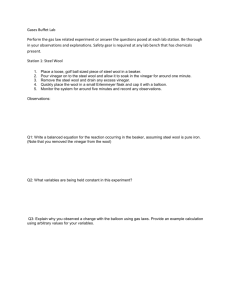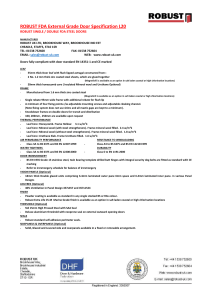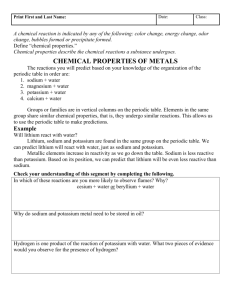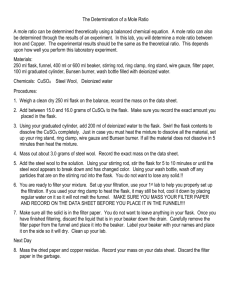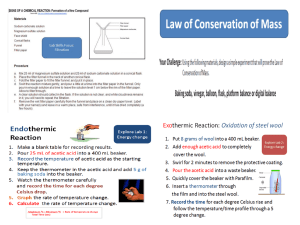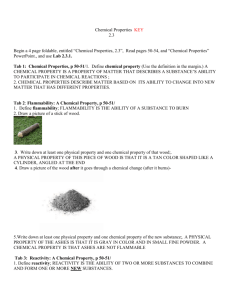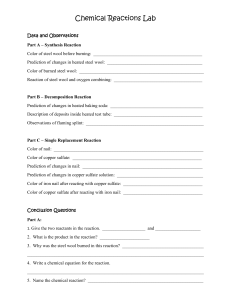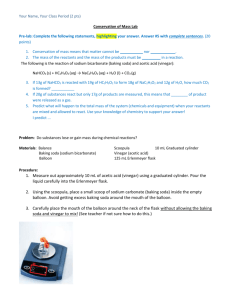Inclined to Accelerate
advertisement
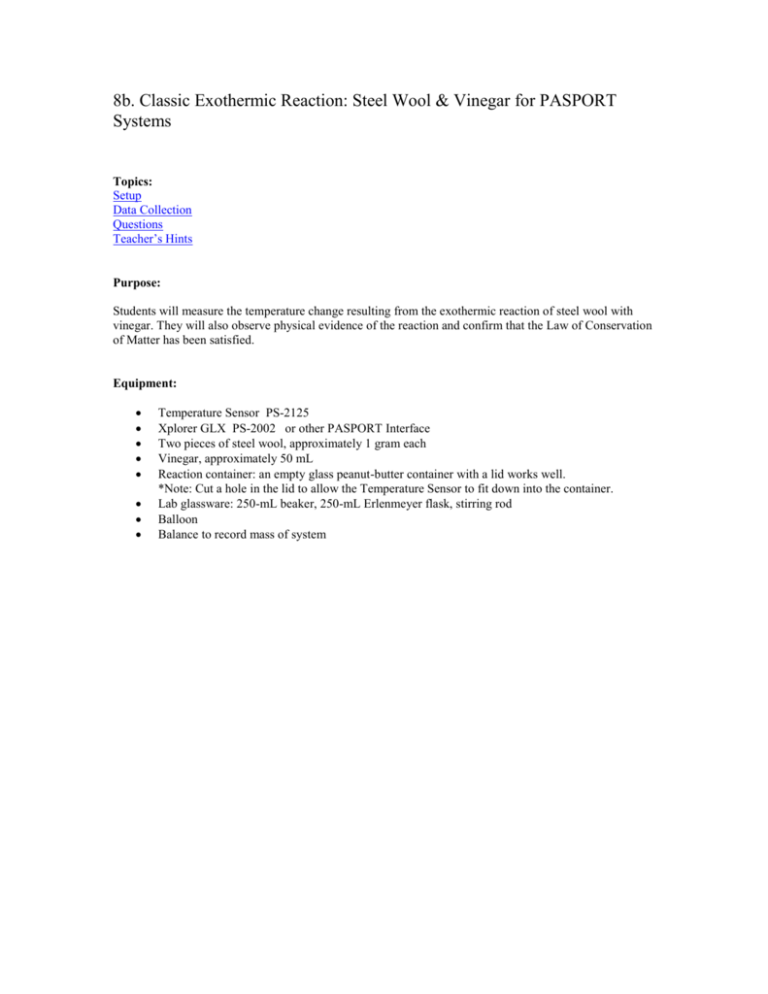
8b. Classic Exothermic Reaction: Steel Wool & Vinegar for PASPORT Systems Topics: Setup Data Collection Questions Teacher’s Hints Purpose: Students will measure the temperature change resulting from the exothermic reaction of steel wool with vinegar. They will also observe physical evidence of the reaction and confirm that the Law of Conservation of Matter has been satisfied. Equipment: Temperature Sensor PS-2125 Xplorer GLX PS-2002 or other PASPORT Interface Two pieces of steel wool, approximately 1 gram each Vinegar, approximately 50 mL Reaction container: an empty glass peanut-butter container with a lid works well. *Note: Cut a hole in the lid to allow the Temperature Sensor to fit down into the container. Lab glassware: 250-mL beaker, 250-mL Erlenmeyer flask, stirring rod Balloon Balance to record mass of system Software & Probeware Setup: 1. Ensure that your PASPORT Interface is connected to the computer. 2. Open the pre-configured DataStudio file included for this experiment. 3. When the file is opened, you should see a Graph Display of Temperature vs. Time, as well as a Digits Display of Temperature. 4. Connect the Temperature Sensor to the PASPORT Interface. 5. Resize and arrange the displays as needed so that you can see them all. Experimental Procedure: Reaction Preparation: 1. Pour the vinegar into the 250-mL beaker and soak the pieces of steel wool in it for at least two minutes. Ensure the entire amount of steel wool is thoroughly soaked. Use the stirring rod to separate and move around the steel wool to get all the bubbles out. 2. Remove one piece of steel wool and wring out any excess vinegar. Place it into the 250-mL flask and cover the opening of the flask with the balloon so that it makes a tight seal. 3. Use the balance to measure and record the mass of the steel wool/balloon/flask system. 4. Set the flask system aside as you complete the remainder of the procedure. 5. Remove the second piece of steel wool from the beaker and wring out any excess vinegar like you did before. 6. Insert the Temperature Sensor through the hole in the lid of the reaction container. 7. Wrap the second steel wool sample around the probe end and tip of the Temperature Sensor, then carefully screw the lid onto the jar. Data Collection & Recording: 1. Click the Start button ( 2. Monitor the temperature for approximately 5 minutes or until no further change is observed, then click the Stop ( ) to begin collecting data. ) button to end data collection. 3. Record the starting and ending temperatures in your data table. 4. Observe the steel wool/balloon/flask system and record those observations in your data table. 5. Clean up lab materials as directed by your instructor, then use the balance to again measure and record the mass of the steel wool/balloon/flask system. Top of the Document Data Analysis: 1. Examine the Graph Display to view your data, using the Scale to Fit button ( toolbar to resize the axes as needed. ) in the Graph 2. Use the Smart Tool ( ) to pinpoint the starting and ending temperatures for the reaction. Record this information in your data table. 3. Compare the Graph Display of Temperature to your observations of the steel wool/balloon/flask system. Identify the reaction that occurred and record it in your data table. Use correct chemical formulas! Sample Data Table: Conclusions and Extensions: 1. What happened to the temperature in the reaction container? Is this evidence of a physical change or a chemical change? 2. What happened to the balloon that was stretched over the mouth of the flask? How can you explain your observations? 3. How did the mass of the steel wool/balloon/flask system before the reaction compare to the mass of the system after the reaction? Explain your observations. 4. Rusting of iron is normally a slow, gradual process. What factors in this experiment contributed to the increased rate of reaction observed? 5. Write and balance a chemical equation for the reaction you observed. Top of the Document Teacher’s Hints: 1. Remind students to consider that vinegar, as a weak acid, serves two purposes in this experiment: first it strips away the protective coating on the steel wool, then it accelerates the oxidation reaction of the iron. 2. This activity demonstrates temperature change (evolution of heat) as evidence that a chemical change has taken place. Ask them to consider what other types of evidence demonstrate chemical reactions. Discuss with students how the breaking and re-forming of chemical bonds involves energy taken from and released into the surroundings. 3. Students’ observations that the mass of the steel wool/balloon/flask system remains the same even though the balloon has been pushed into the flask can provide an excellent starting point for discussing the Law of Conservation of Matter. 4. The balanced chemical reaction for the oxidation of iron is: 4 Fe (s) + 3 O2 (g) --> 2 Fe2 O3 (s) + heat energy The iron is oxidized while the oxygen is reduced. This can be a good starting point for discussing redox reactions with your students. 5. An interesting alternative or addition to this experiment will allow you to determine the percentage of oxygen in air: the reaction takes place in an inverted graduated cylinder, where water is drawn up into the cylinder as the reaction takes place and consumes the oxygen originally trapped in the cylinder. Visit the following site for details: http://www.haverford.edu/educ/knightbooklet/doesironreact.htm
